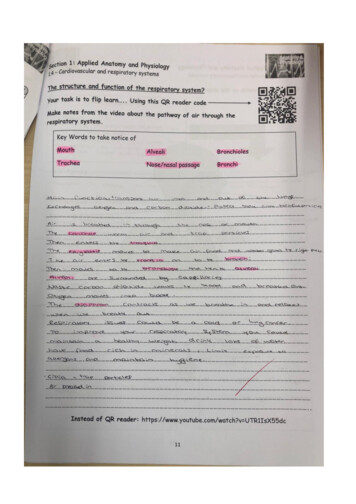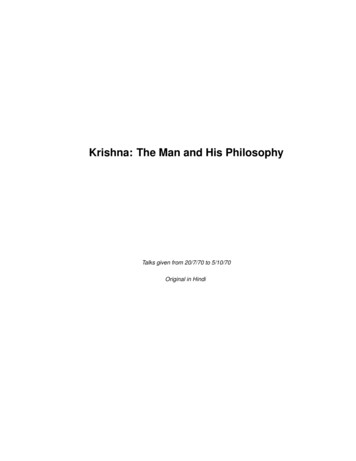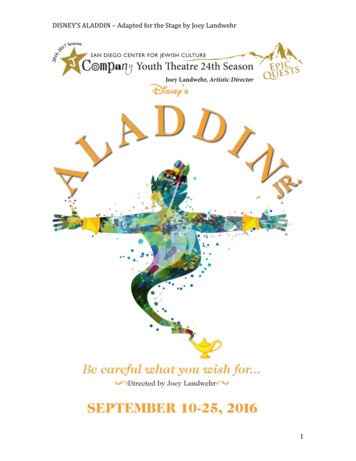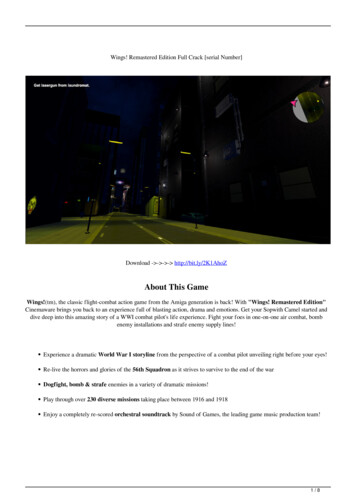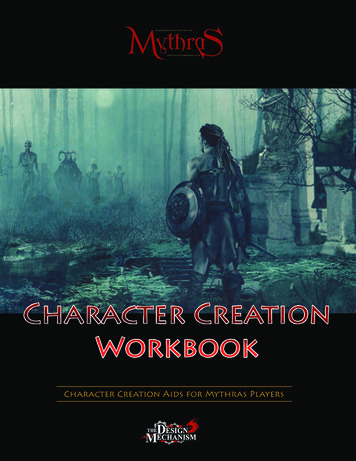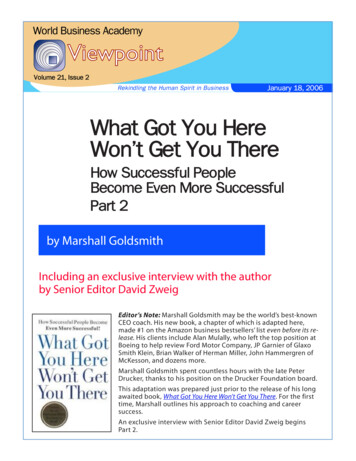
Transcription
Please read the selection below and then answer the questionsthat follow.How the Camel Got His HumpFrom Just So Storiesby Rudyard KiplingIn the beginning of years, when the world was so new and all, and theAnimals were just beginning to work for Man, there was a Camel, and helived in the middle of a Howling Desert because he did not want to work;and besides, he was a Howler himself. So he ate sticks and thorns andtamarisks and milkweed and prickles, most ‘scruciating idle 1 and whenanybody spoke to him he said ‘Humph!’ Just ‘Humph!’ and no more.Presently the Horse came to him on Monday morning, with a saddle onhis back and a bit in his mouth, and said, ‘Camel, O Camel, come out andtrot like the rest of us.’‘Humph!’ said the Camel; and the Horse went away and told the Man.Presently the Dog came to him, with a stick in his mouth, and said,‘Camel, O Camel, come and fetch and carry like the rest of us.’‘Humph!’ said the Camel; and the Dog went away and told the Man.Presently the Ox came to him, with the yoke on his neck and said,‘Camel, O Camel, come and plough like the rest of us.’
‘Humph!’ said the Camel; and the Ox went away and told the Man.At the end of the day the Man called the Horse and the Dog and theOx together, and said, ‘Three, O Three, I'm very sorry for you (with theworld so new-and-all); but that Humph-thing in the Desert can’t work, or hewould have been here by now, so I am going to leave him alone, and youmust work double-time to make up for it.’That made the Three very angry (with the world so new-and-all).Presently there came along the Djinn 2 in charge of All Deserts, rollingin a cloud of dust (Djinns always travel that way because it is Magic), and hestopped to palaver and pow-pow with the Three.‘Djinn of All Deserts,’ said the Horse, ‘is it right for any one to be idle,with the world so new-and-all?’‘Certainly not,’ said the Djinn.‘Well,’ said the Horse, ‘there’s a thing in the middle of your HowlingDesert (and he’s a Howler himself) with a long neck and long legs, and hehasn’t done a stroke of work since Monday morning. He won’t trot.’‘Whew!’ said the Djinn, whistling, ‘that’s my Camel, for all the gold inArabia! What does he say about it?’‘He says “Humph!”’ said the Dog; ‘and he won’t fetch and carry.’‘Does he say anything else?’‘Only “Humph!”; and he won’t plough,’ said the Ox.‘Very good,’ said the Djinn. ‘I’ll humph him if you will kindly wait aminute.’The Djinn rolled himself up in his dust-cloak, and took a bearing acrossthe desert, and found the Camel most ‘scruciatingly idle, looking at his ownreflection in a pool of water.‘My long and bubbling friend,’ said the Djinn, ‘what’s this I hear of yourdoing no work, with the world so new-and-all?’‘Humph!’ said the Camel.
The Djinn sat down, with his chin in his hand, and began to think aGreat Magic, while the Camel looked at his own reflection in the pool ofwater.‘You’ve given the Three extra work ever since Monday morning, all onaccount of your ‘scruciating idleness,’ said the Djinn; and he went onthinking Magics, with his chin in his hand.‘Humph!’ said the Camel.‘I shouldn’t say that again if I were you,’ said the Djinn; ‘you mightsay it once too often. Bubbles, I want you to work.’And the Camel said ‘Humph!’ again; but no sooner had he said it thanhe saw his back, that he was so proud of, puffing up and puffing up into agreat big lolloping humph.‘Do you see that?’ said the Djinn. ‘That’s your very own humph thatyou’ve brought upon your very own self by not working. To-day is Thursday,and you’ve done no work since Monday, when the work began. Now you aregoing to work.’‘How can I,’ said the Camel, ‘with this humph on my back?’‘That’s made a-purpose,’ said the Djinn, ‘all because you missed thosethree days. You will be able to work now for three days without eating,because you can live on your humph; and don’t you ever say I never didanything for you. Come out of the Desert and go to the Three, and behave.Humph yourself!’And the Camel humphed himself, humph and all, and went away tojoin the Three. And from that day to this the Camel always wears a humph(we call it ‘hump’ now, not to hurt his feelings); but he has never yet caughtup with the three days that he missed at the beginning of the world, and hehas never yet learned how to behave.12‘scruciating idle–very, very lazyDjinn–genies or supernatural creatures in Arab folklore and Islamic teachingsSTANDARD: 4.RL.1This task has more than one (1) part. Read each part carefully and respond.Part A
The camel repeats “Humph!” throughout the story. What does the readerlearn about the camel from this? Write a short paragraph that includesdetails from the story to support your response.Part BExplain why the author chose “Humph” as the word repeated by the camel.Write a short paragraph using details from the story to support yourexplanation.Be sure to complete ALL parts of the task.Answer with complete sentences, and use correct punctuation andgrammar.
stratedThe student provides a thorough explanation of why itwas important for the Camel’s character (Part A) andfor the story (Part B) that the author chose theword humph by using many specific relevant detailsfrom the text. The response must demonstrate athorough command of the conventions of standardEnglish. Though there may be a few minor errors ingrammar and usage, meaning is clear throughout theresponse.3ClearlyDemonstratedThe student provides a simple but accurate explanationin each paragraph of why it was important that theauthor chose the word humph. The student provides afew relevant details from the text; some may be general.The response must demonstrate a command of theconventions of standard English. There may be a fewdistracting errors in grammar and usage, but meaning isclear.2BasicallyDemonstratedThe student provides a general explanation of why itwas important that the author chose theword, humph with minimal support and some supportmay be incorrect or irrelevantORThe student writes one paragraph that is developed andone that is not clear or is not as developed. Someminimal text support may be incorrect or irrelevant. Theresponse may demonstrate an inconsistent command ofthe conventions of standard English. There are a fewpatterns of errors in grammar and usage that mayoccasionally impede understanding.1MinimallyDemonstratedThe student provides only a limited explanation of whyit was important for either the Camel’s character or thestory that the author chose the word, humphORThe student writes one very underdeveloped paragraphwith no text support. The response may demonstratelimited command of the conventions of standardEnglish. There are multiple distracting errors ingrammar and usage that impede understanding.0Incorrect orIrrelevantThe response is incorrect or irrelevant.
e student provides a thorough explanation ofDemonstrated why it was important for the Camel’s character(Part A) and for the story (Part B) that theauthor chose the word humph by using manyspecific relevant details from the text. Theresponse must demonstrate a thoroughcommand of the conventions of standard English.Though there may be a few minor errors ingrammar and usage, meaning is clearthroughout the response.ClearlyThe student provides a simple but accurateDemonstrated explanation in each paragraph of why it wasimportant that the author chose the wordhumph. The student provides a few relevantdetails from the text; some may be general. Theresponse must demonstrate a command of theconventions of standard English. There may be afew distracting errors in grammar and usage, butmeaning is clear.BasicallyThe student provides a general explanation ofDemonstrated why it was important that the author chose theword, humph with minimal support and somesupport may be incorrect or irrelevantORThe student writes one paragraph that isdeveloped and one that is not clear or is not asdeveloped. Some minimal text support may beincorrect or irrelevant. The response maydemonstrate an inconsistent command of theconventions of standard English. There are a fewpatterns of errors in grammar and usage thatmay occasionally impede understanding.MinimallyThe student provides only a limited explanationDemonstrated of why it was important for either the Camel’scharacter or the story that the author chose theword, humphORThe student writes one very underdevelopedparagraph with no text support. The responsemay demonstrate limited command of theconventions of standard English. There aremultiple distracting errors in grammar and usagethat impede understanding.Incorrect orThe response is incorrect or irrelevant.Irrelevant
ExemplarPart A“Humph” is an important word in the story, because it shows over and overagain how the Camel feels about work. He says it because he is complaining.Saying it is his way of complaining. The camel says it when he is supposed tocome out and trot and fetch and carry and plough. He just says “humph” to sayhe hates to work.Part BThe author chose “humph” as the word the camel repeats because is it verysimilar to hump. Camels have humps. The camel gets a hump because when theCamel says “humph” to the Djinn, the Djinn is mad and says to the Camel, “Ishouldn’t say that again if I were you,” but he does anyway. The Djinn then useshis magic to give the Camel a hump (humph) on his back.
ExemplarPart A“Humph” is an important word in the story, because it shows over and over again how the Camel feels aboutwork. He says it because he is complaining. Saying it is his way of complaining. The camel says it when he issupposed to come out and trot and fetch and carry and plough. He just says “humph” to say he hates to work.Part BThe author chose “humph” as the word the camel repeats because is it very similar to hump. Camels havehumps. The camel gets a hump because when the Camel says “humph” to the Djinn, the Djinn is mad andsays to the Camel, “I shouldn’t say that again if I were you,” but he does anyway. The Djinn then uses hismagic to give the Camel a hump (humph) on his back.Score 4
B. The author choose "humph" as the word repeated by the camel because it was really close to the word"hump". It was also a way to express that he was lazy and did not like doing any type of work. "Humphmeans you are ignoreing others if they are trying to talk to you.The student demonstrates a clear understanding by providing a simple butaccurate explanation of why it was important for the Camel’s character that theauthor chose the word humph (It was also a way to express that he was lazyand did not like doing any type of work. "Humph means you are ignoreingothers if they are trying to talk to you) and for the story (B. The author choose"humph" as the word repeated by the camel because it was really close to theword "hump"). The student provides a few relevant details from the text; someare general (It was also a way to express that he was lazy and did not likedoing any type of work). The response demonstrates a command of theconventions of standard English. There is one distracting error in grammar andusage, but meaning is clear (B. The author choose "humph" as the wordrepeated by the camel).Score 3
PART A. When the Camel says "Humph" the reader learns that he doesnt want to be botherd and is lazyand doesent want to do work at all. PART B. because the camel says "humph" and the last time he said"humph" the Djinn gave him a "humph" and since the dident work for 3 days utill he caught up his work hecould not eat.The student demonstrates a basic understanding by providing an explanation of why itwas important for the Camel’s character (PART A. When the Camel says "Humph" thereader learns that he doesnt want to be botherd and is lazy and doesent want to dowork at all) and for the story that the author chose the word humph (PART B. becausethe camel says "humph" and the last time he said "humph" the Djinn gave him a"humph"). Some minimal text support is irrelevant (. . . since the dident work for 3days utill he caught up his work he could not eat). The response demonstrates aninconsistent command of the conventions of standard English. There is a pattern oferrors that occasionally impedes understanding (PART B. because the camel says"humph" and the last time he said "humph" the Djinn gave him a "humph" and sincethe dident work for 3 days utill he caught up his work he could not eat).Score 2
The camel reapeats Humph because at the end of the story the Djinn goes and tals to the camel becausehe wont stop saying the word Humph to everyone. When he talk to him he notises a large humph on hisback. And the camel wonders how he will work. Then he finds a way. But today we call it a hump.Part AThe student demonstrates a basic understanding by providing an explanation of whyit was important for the Camel’s character (. . . .the Djinn goes and tals to the camelbecause he wont stop saying the word Humph ) and for the story that the authorchose the word humph (When he talk to him he notises a large humph on his back. . .But today we call it a hump). Some minimal text support is irrelevant (And the camelwonders how he will work. Then he finds a way). The response demonstrates aninconsistent command of the conventions of standard English. There are a few errorsthat occasionally impede understanding.Score 2
Part A what the reader learns from this is that the camel is mean by not helping the three otheranimals.Part B the reason I think the author used the word humph is because saying humph one two manytimes gave him his hump.The student demonstrates a basic understanding by providing an explanation usingminimal support from the text of why it was important for the Camel’s character(Part A what the reader learns from this is that the camel is mean by not helpingthe three other animals) and for the story that the author chose the word humph(Part B the reason I think the author used the word humph is because sayinghumph one two many times gave him his hump). The response demonstrates acommand of the conventions of standard English. There are a few errors, butmeaning is clear (Part A what the reader learns. . . .Part B the reason I think theauthor used the word humph).Score 2
Part B:The author chose the word humph because its talking about a camel and the camel didn't have ahumph but then the Djinn gave him a humph. Part A: The reader can learn that some camels might somehumph and that the camel got his humph from that.The student provides only a limited explanation of why it wasimportant that the author chose the word humph (. . . . the cameldidn't have a humph but then the Djinn gave him a humph. . .). Theresponse demonstrates an inconsistent command of the conventionsof standard English. There are a few errors that occasionally impedeunderstanding.Score 1
Part A:About the camel's hump. Part B:Humph is like saying hump.The student provides only a limited explanation of why it wasimportant for either the Camel’s character or the story that theauthor chose the word humph (Part B:Humph is like sayinghump). The response demonstrates an inconsistent command ofthe conventions of standard English. There are a few errors thatmay occasionally impede understanding (Part A:About thecamel's hump).Score 1
he has a hump on his backThe student provides only a limited explanation of why it wasimportant for the story that the author chose the word humph (hehas a hump on his back). The response demonstrates aninconsistent command of the conventions of standard English.Score 1
Well,I think he said humph because his humph hert or he was trying to say somethingThe response is incorrect.Score 0
he can't carry and featThe response is incorrect.Score 0
Great Magic, while the Camel looked at his own reflection in the pool of water. ‘You’ve given the Three extra work ever since Monday morning, all on account of your ‘scruciating idleness,’ said the Djinn; and he went on thinking Ma
